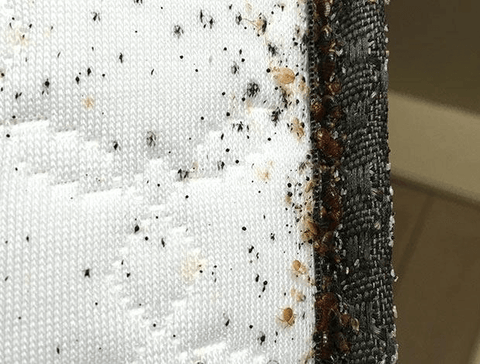Reading time: 2:10 minutes
What are the signs of bedbugs?
Being a discerning individual, it is essential to be able to quickly detect the presence of bed bugs by being able to recognize the signs and symptoms they produce. These signs and symptoms can be easily spotted by knowing how to identify them. Bed bugs are blood-feeding insects, and the most common variety adapted to human habitats is the Cimex Lectarius, recognizable by its brown/red color and its oval, flattened shape, similar to an apple seed once it is fully grown. Despite their ability to hide, it is important to remain alert to signs that may indicate the presence of bed bugs.
If you want to learn how to find bed bugs, it's recommended to have a small flashlight and a small knife, which can be very useful for spotting them. The main signs to look for include the bed bugs themselves, their carcasses, blood stains on sheets, and black spots on various objects, such as the mattress, furniture, baseboards, picture frames, and curtains. Can you recognize these signs of bed bugs in your own home or in a loved one's home? It's important to be vigilant and know how to identify these signs so you can take the necessary steps quickly to prevent or eliminate an infestation.
How to find bed bugs themselves?
Bed bugs normally avoid light. The best time to find them is around 2:00 AM. Get up without turning on the light. Just turn on your flashlight and check under your sheets, headboard, nightstands, bed frame, and mattress. Be careful, as bed bugs can quickly flee if they see the light.
How to find bed bug shells?
Bed bug shells are sometimes found on parts of the bed frame that support the mattress or simply on the floor. It is often mistakenly believed that these are pellets, but upon closer inspection, they can be recognized as the morphological characteristics of bed bugs. The presence of shells is an important sign of the presence of bed bugs.
How to find blood stains on sheets?
Blood stains left by bed bugs on sheets are caused either by overflow (droplet) at the time of the bite, by slight bleeding following the bite, or by accidentally crushing a blood-engorged bed bug while the person is sleeping. The presence of blood stains is an important indicator of the presence of bed bugs.
How to find black bed bug spots?
Black spots (on sheets, mattresses, or bed wood, furniture, baseboards, behind picture frames, curtains, etc.) are also signs and important clues to the presence of bedbugs. These spots have a similar appearance to those left by flies in our homes in terms of color and size.

What are the symptoms of bedbugs?
The most common symptoms caused by bedbugs are skin reactions following bites and attacks of pruritus (intense tingling causing the urge to scratch).
Skin reactions to bedbug bites can take several forms, including redness, small papules (swellings), hives, and bullous reactions (blisters) filled with fluid and sometimes blood. However, it is important to know that a portion of the population does not experience any reaction to bedbug bites.
Some tips while waiting to treat the infestation
- Don't move your furniture or clothes around, you're moving the problem around without eliminating it.
Avoid sleeping anywhere else in your apartment, otherwise you risk bringing bedbugs somewhere other than your room. (Some of the bedbugs may follow you.) - Don't throw anything away! Everything can be saved. If you can't, don't forget to report your items as infested. Otherwise, throw them in the trash under plastic wrap.
1# Why are they invading our homes?
The abandonment of the widespread use of powerful pesticides (DDT, etc.) as well as the increase in international travel seem to have largely contributed to the reappearance of bedbugs in our homes and dwellings. In addition, bedbugs have developed resistance to several insecticides that were once used to eradicate them. The appearance of automatic thermostat-controlled heaters is not unrelated to the rapid spread of bedbugs since this provides them with a stable temperature required for their rapid development.
2# Where do they hide most often?
Never far from their victims! Start looking for clues of their presence near the mattress, in cracks, in bed frames, on/under/in bedside tables, under rugs, behind picture frames, in curtains, etc.
3# How do you know if your home is infested with bedbugs?
If you or a loved one experiences red, blistered, itchy bites, usually located on the arms in groups of three or four, or if you notice blood stains on your sheets or pillow, or black spots along the seams of your mattress, you should be alerted. In these cases, it is recommended to conduct a thorough inspection of your home, especially the bedrooms.
Pay attention to mattress seams, box springs, and sheets for signs of bed bugs. If you find droppings, shells, eggs, or insects, treat immediately with specialized bed bug products .

